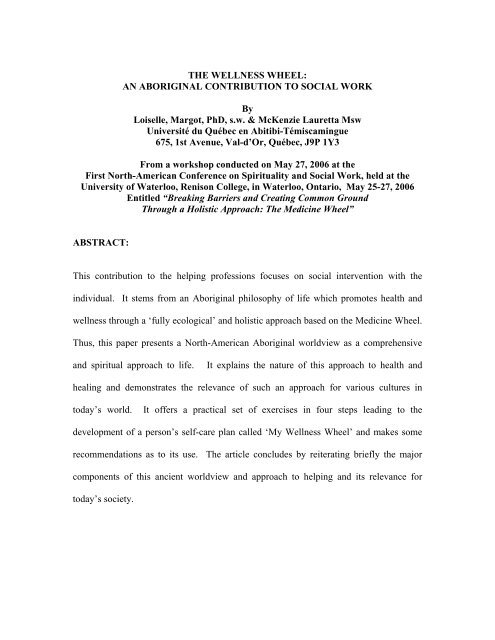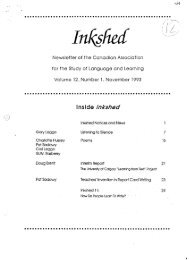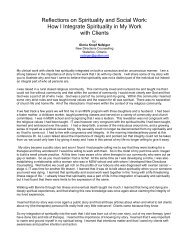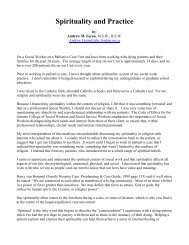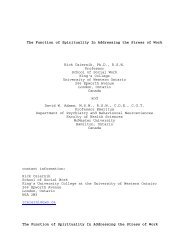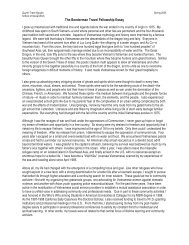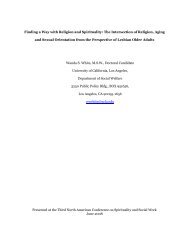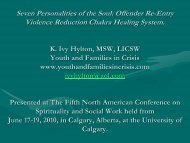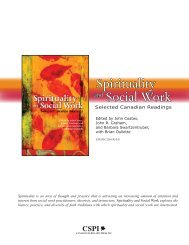The Wellness Wheel: An Aboriginal Contribution to Social Work
The Wellness Wheel: An Aboriginal Contribution to Social Work
The Wellness Wheel: An Aboriginal Contribution to Social Work
Create successful ePaper yourself
Turn your PDF publications into a flip-book with our unique Google optimized e-Paper software.
THE WELLNESS WHEEL:<br />
AN ABORIGINAL CONTRIBUTION TO SOCIAL WORK<br />
By<br />
Loiselle, Margot, PhD, s.w. & McKenzie Lauretta Msw<br />
Université du Québec en Abitibi-Témiscamingue<br />
675, 1st Avenue, Val-d’Or, Québec, J9P 1Y3<br />
From a workshop conducted on May 27, 2006 at the<br />
First North-American Conference on Spirituality and <strong>Social</strong> <strong>Work</strong>, held at the<br />
University of Waterloo, Renison College, in Waterloo, Ontario, May 25-27, 2006<br />
Entitled “Breaking Barriers and Creating Common Ground<br />
Through a Holistic Approach: <strong>The</strong> Medicine <strong>Wheel</strong>”<br />
ABSTRACT:<br />
This contribution <strong>to</strong> the helping professions focuses on social intervention with the<br />
individual. It stems from an <strong>Aboriginal</strong> philosophy of life which promotes health and<br />
wellness through a ‘fully ecological’ and holistic approach based on the Medicine <strong>Wheel</strong>.<br />
Thus, this paper presents a North-American <strong>Aboriginal</strong> worldview as a comprehensive<br />
and spiritual approach <strong>to</strong> life.<br />
It explains the nature of this approach <strong>to</strong> health and<br />
healing and demonstrates the relevance of such an approach for various cultures in<br />
<strong>to</strong>day’s world. It offers a practical set of exercises in four steps leading <strong>to</strong> the<br />
development of a person’s self-care plan called ‘My <strong>Wellness</strong> <strong>Wheel</strong>’ and makes some<br />
recommendations as <strong>to</strong> its use. <strong>The</strong> article concludes by reiterating briefly the major<br />
components of this ancient worldview and approach <strong>to</strong> helping and its relevance for<br />
<strong>to</strong>day’s society.
TABLE OF CONTENTS<br />
Page<br />
1. Introduction 3<br />
2. <strong>The</strong> Native Worldview and Philosophy of Life 4<br />
3. <strong>The</strong> Nature and Relevance of a Holistic, ‘Fully Ecological’ Approach <strong>to</strong><br />
Wellbeing 7<br />
4. <strong>The</strong> Medicine <strong>Wheel</strong>: Characteristics and Objectives 11<br />
5. <strong>The</strong> <strong>Wellness</strong> <strong>Wheel</strong>: A Program in Four Steps: 12<br />
Step 1: ‘My Life Today’: A Snapshot 13<br />
Step 2: ‘My Life Today’: A Graph 14<br />
Step 3: Reflection on My Life 15<br />
Step 4: ‘My <strong>Wellness</strong> <strong>Wheel</strong> - A Self-Care Plan 17<br />
6. Recommendations 18<br />
7. Conclusion 19<br />
8. References 20<br />
2
1. Introduction<br />
THE WELLNESS WHEEL:<br />
AN ABORIGINAL CONTRIBUTION TO SOCIAL WORK<br />
According <strong>to</strong> Calvin Morrisseau, an Ojibway healer (1998:90), the fundamental<br />
principle of life “is not <strong>to</strong> get <strong>to</strong> the end of the Red Road but <strong>to</strong> enjoy the journey”. Life<br />
is a path on which the traveler is invited by the Crea<strong>to</strong>r <strong>to</strong> grow and develop in all aspects<br />
of life, so that each one can find his* true identity, become aware and respectful of his<br />
inherent dignity and manifest his inner goodness along the way. In this manner, each<br />
individual contributes <strong>to</strong> the collective well-being of the whole. Such is North American<br />
<strong>Aboriginal</strong> peoples’ basic belief, that humanity is a part of nature which was created by a<br />
Great Spirit, each person being a sojourner in the great circle of life. <strong>The</strong> Crea<strong>to</strong>r’s<br />
purpose for human beings is wellness, peace and happiness. <strong>The</strong>se are achieved through<br />
individual effort <strong>to</strong>ward the attainment of balance and harmony in life and the fulfilment<br />
of personal potential.<br />
<strong>The</strong> goal of this article is <strong>to</strong> offer a contribution <strong>to</strong> the helping professions<br />
involved in promoting health and wellness for individuals, families and communities.<br />
<strong>The</strong> premise originates from the North American <strong>Aboriginal</strong> Medicine <strong>Wheel</strong> as a<br />
holistic approach that aims <strong>to</strong> promote well-being at all levels of society as well as in all<br />
realms of human functioning, i.e. the body, the heart, the mind and the soul. While<br />
acknowledging the power of the Medicine <strong>Wheel</strong> <strong>to</strong> work with groups and help transform<br />
social relations at different levels of society, this paper focuses on intervention with the<br />
individual. Practitioners involved in helping families and communities may adapt the<br />
basic formula offered in this paper <strong>to</strong> their particular needs.<br />
* <strong>The</strong> authors utilize the masculine pronoun in a generic way in order <strong>to</strong> facilitate the reading of the article.<br />
3
<strong>The</strong> authors begin by explaining a North American <strong>Aboriginal</strong> worldview as well<br />
as a philosophical perspective of life. <strong>The</strong>y describe the nature of a holistic approach <strong>to</strong><br />
well-being and demonstrate its relevance, not only in <strong>Aboriginal</strong> milieu, but for people of<br />
various cultures in <strong>to</strong>day’s society. <strong>The</strong>y then identify the characteristics and objectives<br />
of the Medicine <strong>Wheel</strong>. In preparation for the development of an individual’s own<br />
wellness plan, a four-step concrete and practical set of exercises is proposed and followed<br />
with recommendations for assessing self-progress in the pursuit of balance and harmony<br />
in one’s life. <strong>The</strong> authors conclude the article by reaffirming their position about the<br />
relevance of this approach <strong>to</strong> helping and healing in <strong>to</strong>day’s modern world.<br />
2. <strong>The</strong> <strong>Aboriginal</strong> Worldview and Philosophy of Life and <strong>Wellness</strong><br />
<strong>The</strong> <strong>Aboriginal</strong> worldview is comprehensive and spiritual in nature (Bopp et al,<br />
1984; Laugrand, 2002; Mehl-Madrona, 1998 & 2003). It is indeed impossible <strong>to</strong> discuss<br />
this worldview without considering spirituality as a vital element since it is seen as<br />
pervading every aspect of life (Royal Commission on <strong>Aboriginal</strong> Peoples, 1996).<br />
According <strong>to</strong> Morrisseau, (1998:88), the Native significance and purpose of spirituality is<br />
“the process and relationship we have with our greater power… the part of you which<br />
helps you see the beauty along the way…[and] the goodness in [others]”.<br />
Duran & Duran (1995:15), for their part, describe the <strong>Aboriginal</strong> perspective of<br />
life as “a systemic approach <strong>to</strong> being in the world” (our emphasis). <strong>The</strong>y consider it<br />
more important <strong>to</strong> develop our ‘being’, than <strong>to</strong> grow in our capacity for ‘doing’ or<br />
‘having’. It also implies being part of nature, that is, connected <strong>to</strong> and respectful of all of<br />
creation, since all created things are considered <strong>to</strong> have a spirit and <strong>to</strong> be alive (Ross,<br />
4
2006). Graveline (1998) explores the development of several constructs that form the<br />
basis of an <strong>Aboriginal</strong> worldview which she refers <strong>to</strong> as “Self-in-relation” (p. 57), that is:<br />
immanence (respect for all life forms), interconnectedness and balance.<br />
In this perspective, every created thing and every human being are respected,<br />
valued as sacred and connected <strong>to</strong> the whole of creation and <strong>to</strong> the Crea<strong>to</strong>r. This<br />
worldview is therefore ‘fully ecological’ in the sense that it is considerate of all types of<br />
relationships: human <strong>to</strong> human, human <strong>to</strong> non-human, human <strong>to</strong> the Crea<strong>to</strong>r. This<br />
implies a call for respect of ‘Mother Earth’ and all it contains. Indeed it considers “the<br />
health of the Earth as central <strong>to</strong> human existence and wellbeing” as Coates (2003:57)<br />
puts it.<br />
<strong>The</strong> invisible spiritual world and the visible material world are not seen as<br />
separate entities. Spiritual influences are all pervasive and interacting with all elements<br />
in the flow of physical life. Both spheres of life are viewed as being interconnected and<br />
inseparable, the concepts of spirituality and life being perceived as one and the same<br />
(Royal Commission, 1996). To this effect, the Swinomish Tribal Mental Health Project<br />
(1991:137) states that “there is a spiritual side <strong>to</strong> all living and natural things, not only <strong>to</strong><br />
human beings”: animals, plants and minerals possess life spirit (Cajete, 1994; Graveline,<br />
1998; Mehl-Madrona, 1998: Ross, 2006; Sioui, 1989). Moreover, “all things and all<br />
thoughts are related through spirit” (Cajete, 1994:44, cited in Hart 2002:46). For<br />
example, air, water, the sun (fire), and mother earth are the combined sources of life for<br />
humans and other beings. If any one of these elements becomes exhausted, death and<br />
annihilation are a sure consequence. Thus, these basic elements are highly valued and<br />
respected in the <strong>Aboriginal</strong> peoples’ ecological worldview.<br />
5
<strong>The</strong> notions of wholeness and interconnectedness lead <strong>to</strong> another fundamental<br />
<strong>Aboriginal</strong> concept: that of balance. <strong>The</strong>se notions represent the inclusion of all aspects<br />
of one’s inner and outer life and imply the requirement of a balanced attribution of<br />
energy, attention and care between all components of a human being, i.e. the physical, the<br />
emotional, the mental and the spiritual, and between all related systems. From balance<br />
emerges justice, peace and harmony, affirms Hart (2002). Living in harmony is<br />
perceived as a necessity. Failure <strong>to</strong> do so puts people and the environment in positions of<br />
vulnerability and danger (Swinomish Tribal Mental Health Projects, 1991). Harmony is<br />
health, disharmony is illness. Like diabetes, disharmony causes malfunctions in other<br />
parts of the body being affected, be it at the individual or at any other level of society.<br />
From the above description of <strong>Aboriginal</strong> worldview and philosophy of life and<br />
wellness, it follows that, as stated by Sioui (1989:14), “the duty of man is <strong>to</strong> work for the<br />
Great Spirit” (translated by Loiselle) (see also Ouellette, 2002). ‘<strong>Work</strong>ing for the Great<br />
Spirit’ means that each person works, or is intended <strong>to</strong> work, for the good of His entire<br />
creation. Thus, each individual carries a responsibility for the well-being of the whole,<br />
be it the family, the community, the larger society or the world, including future<br />
generations (Ouellette, 2002). From the consciousness of one’s duty and responsibility in<br />
the world, awareness of personal accountability becomes acute as stated by Graveline<br />
(1998:58): “Through embracing this worldview, each individual becomes intensely<br />
aware of personal accountability for the welfare of others”.<br />
Figure no. 1, below, presents a graphic description of an <strong>Aboriginal</strong><br />
comprehensive worldview. <strong>The</strong> diagram is an integration of spirals originating from two<br />
sources: Graveline (1998:58) and Swinomish Tribal Mental Health Project (1991:127).<br />
6
A central core, in the form of a black circle, is added <strong>to</strong> the original combined spirals by<br />
the present authors <strong>to</strong> represent the individual’s soul and conscience, as well as the seat of<br />
consciousness from where stems, in the words of Bopp et al (1985:37), “the journey of<br />
authentic human development”. <strong>The</strong> spiral itself indicates the intersecting growth and<br />
development of all aspects in the flow of life.<br />
Figure No. 1: <strong>The</strong> spiral of interconnectedness and interdependence<br />
3. <strong>The</strong> Nature and Relevance of a Holistic, ‘Fully Ecological’ Approach <strong>to</strong> <strong>Wellness</strong><br />
<strong>The</strong> <strong>Aboriginal</strong> worldview is best portrayed by a circular or holistic vision. <strong>The</strong><br />
circle represents the cyclical and harmonious pattern of life. According <strong>to</strong> most North-<br />
American Native cultures, “space is spherical and time is cyclical” Graveline (1998:59).<br />
From an <strong>Aboriginal</strong> perspective, the circle also symbolizes unity, wholeness,<br />
continuation, perpetuity, inseparability, completeness, balance, security, equality, comfort<br />
7
and health. <strong>The</strong> well known Sioux Medicine man, Hehaka Sapa or Black Elk<br />
summarized the significance of the circle from his Native way of seeing:<br />
“All things created by the Great Power, He made in the shape of a circle.<br />
<strong>The</strong> sky is circular and I heard that the earth is round like a ball and the<br />
stars <strong>to</strong>o are round. <strong>The</strong> wind, in its greatest force, whirls. <strong>The</strong> birds<br />
make their nests in the form of a circle because they have the same<br />
religion as us. Our teepees were circular like the birds’ nests and were<br />
always arranged in a circle – the circle of the nation, a nest made of many<br />
nests where the Great Spirit wished that we protect and nurture our<br />
children” (cited in Sioui, 1989:13 – translated by M. Loiselle).<br />
<strong>The</strong> circle is also a reminder that important universal spiritual principles of<br />
behaviour such as love, kindness, patience, sharing, caring, honesty, truthfulness,<br />
trustworthiness, justice and humility are conducive <strong>to</strong> well-being and healthy<br />
relationships.<br />
<strong>The</strong> “circular nature [of the circle]” explains Mehl-Madrona (2003:99) “ensures<br />
that the whole is addressed [as it] informs us that all its elements are related <strong>to</strong> each<br />
other”. No single element at any level or of any kind can thus be treated in isolation.<br />
Mehl-Madrona (2003:99) further states that “action or work on one element leads <strong>to</strong><br />
potential change in any other element”. Systems theory also maintains that balance is<br />
essential <strong>to</strong> health (<strong>An</strong>drea, 1996) and stipulates that change in one component of a<br />
system has a rippling effect on all other components (Barker, 2003; Miley, K.K. O’Melia,<br />
M. and DuBois, B. 2004). Indeed, Duran & Duran confirm that the Native way of<br />
thinking and seeing the world is a systemic one. In addition <strong>to</strong> being systemic, the most<br />
relevant social work approach <strong>to</strong> health and wellness is a holistic one in <strong>Aboriginal</strong> view,<br />
since it identifies with an all-encompassing philosophy of life and addresses all aspects of<br />
the “self-in-relation” (Graveline, 1998:57). This view affirms, for example, that the fish,<br />
the lake and its entire surroundings, must all be treated equally in order for well-being <strong>to</strong><br />
8
e res<strong>to</strong>red and sustained. Such a view is also fully and truly ecological. As Coates’<br />
(2003:156) argues, when speaking of an “unfolding paradigm”… “a goal of social work<br />
will be <strong>to</strong> help create conditions that provide an opportunity for every person and all of<br />
nature <strong>to</strong> achieve fulfillment…”. <strong>The</strong> ‘unfolding paradigm’ thus stems from an ancient<br />
source: the Medicine <strong>Wheel</strong>.<br />
<strong>An</strong>other aspect of the nature of an <strong>Aboriginal</strong> approach is the view that the world<br />
in which we live is composed of four cardinal directions existing in harmony, balance,<br />
complementarity and unity: east, south, west and north. Each of these directions<br />
corresponds <strong>to</strong> one component of a person’s being as identified in the Medicine <strong>Wheel</strong>:<br />
the physical/material, the emotional/relational, the mental/intellectual and the<br />
spiritual/cultural. This connection between the four complementary cardinal directions<br />
and the four facets of the self symbolically signifies that balance and wholeness are<br />
essential <strong>to</strong> the development of one’s full potential (Hart, 2002; Morrisseau, 1998; Royal<br />
Commission, 1996). Caring equally for each of these facets is therefore vital <strong>to</strong> the<br />
attainment of a person’s full potential which will, in turn, enhance the well-being of all<br />
created things.<br />
<strong>The</strong> <strong>Aboriginal</strong> holistic view of health and of the healing process through the<br />
Medicine <strong>Wheel</strong> is relevant in <strong>to</strong>day’s world as confirmed by the two following<br />
statements. First, the World Health Organization’s (WHO, 2006:1) constitution defines<br />
health as “a state of complete physical, mental and social well-being…”. Second, Penny<br />
Ericson, the Dean of the Faculty of Nursing at the University of New Brunswick, stated<br />
the following when addressing the Royal Commission of <strong>Aboriginal</strong> Peoples during a<br />
public consultation session:<br />
9
« It is powerful for <strong>Aboriginal</strong> people <strong>to</strong> realize that one of their<br />
traditional approaches <strong>to</strong> health [the Medicine <strong>Wheel</strong>] is now viewed as<br />
progressive and crucial by health care educa<strong>to</strong>rs and policy planners<br />
within the United Nations and in Canada. […] <strong>The</strong> interplay of the<br />
physical, emotional, social and spiritual for achieving well-being has long<br />
been inherent in the aboriginal health paradigm and is now appearing as<br />
a stated value in health care teaching in Canada” (Royal Commission,<br />
1996, p. 5 on website)<br />
Moreover, the Medicine <strong>Wheel</strong> combines both the ‘emic’ (based on cultural<br />
particularities) and ‘etic’ (based on universally shared human characteristics) (Canda,<br />
1999; Massé, 1995) approaches <strong>to</strong> helping and is adaptable <strong>to</strong> a variety of cultures.<br />
Human cultures differ in a number of ways: in their value systems, worldviews, guiding<br />
principles, thinking and learning processes, cus<strong>to</strong>ms, practices and means for attaining<br />
goals. However, in their fundamental nature, human beings share many similarities with<br />
regard <strong>to</strong> the four components of the Medicine <strong>Wheel</strong>. <strong>The</strong>ir basic needs are the same;<br />
they feel similar emotions in similar situations; harmonious relationships, identity,<br />
recognition and a sense of belonging are individual aspirations in all cultures; human<br />
beings of all backgrounds have capacities for creative, rational, logical and intellectual<br />
functioning; all humans have choice of thoughts and attitudes when confronted with<br />
moral and ethical issues; desires for the spiritual qualities of love, justice, unity and peace<br />
and for general happiness are universal. According <strong>to</strong> Bopp et al (1984), all humans also<br />
have the capacity <strong>to</strong> grow and <strong>to</strong> change. Just as Canda (1999) and Massé (1995), who<br />
argue that both approaches, ‘emic’ and ‘etic’, in situations of cultural diversity, must be<br />
combined in<strong>to</strong> a “transemic approach” (Canda 1999:39) in addressing issues of health<br />
and wellness, so <strong>to</strong>o does the <strong>Aboriginal</strong> view of social work.<br />
10
4. <strong>The</strong> Medicine <strong>Wheel</strong> : characteristics and objectives<br />
<strong>The</strong> Medicine <strong>Wheel</strong>, from which the <strong>Wellness</strong> <strong>Wheel</strong> originates, constitutes the<br />
foundation of <strong>Aboriginal</strong> healing practices. It is an ancient symbol of the universe and a<br />
sacred item that has been used from time immemorial (Bopp et al, 1984) by most<br />
indigenous nations. It is meant <strong>to</strong> provide direction and guidance for understanding the<br />
process of life and for striving <strong>to</strong> achieve well-being (Nabigon and Mawhiney 1996;<br />
Swinomish Tribal Mental Health Project, 1991). Each individual has within the self a<br />
‘wheel of life’ or Medicine <strong>Wheel</strong>.<br />
<strong>The</strong>re is no absolute universal version of the wheel, as pointed out by Hart (2002).<br />
<strong>The</strong>re are culturally specific ways of presenting it and many possible adaptations of it<br />
according <strong>to</strong> how a healer or practitioner intends <strong>to</strong> apply it and depending on the needs<br />
and circumstances of a client. <strong>The</strong> four-step process of an individual’s <strong>Wellness</strong> <strong>Wheel</strong><br />
presented in this paper is an adaptation, by the authors, of the basic Medicine <strong>Wheel</strong>.<br />
<strong>The</strong> Medicine <strong>Wheel</strong> is a pro-active and empowering approach <strong>to</strong> social<br />
intervention with individuals as well as a self-help <strong>to</strong>ol. It is a framework that presents a<br />
complete picture of a ‘person-in-environment’ and provides a map or plan for problem<br />
solving, for enhancing one’s awareness and understanding of self and for res<strong>to</strong>ring<br />
healthy relationships and general well-being (Nabigon & Mawhiney, 1996). <strong>The</strong> wheel is<br />
meant <strong>to</strong> be an awakening for the individual <strong>to</strong> acknowledge and accept responsibility for<br />
his behaviour and <strong>to</strong> become accountable <strong>to</strong> his family, his community, society, including<br />
past and future generations. Its concepts remind the individual that the only person he<br />
can change is himself and recalls simple, albeit profound, principles that need <strong>to</strong> be<br />
applied in order <strong>to</strong> ensure wellness.<br />
11
<strong>The</strong> Medicine <strong>Wheel</strong> graphically identifies small steps that one can take on the<br />
self-help path <strong>to</strong> recovery and wholeness. This <strong>to</strong>ol is a positive visual incentive for<br />
motivation and stimulation of the volition <strong>to</strong> change one’s negative and destructive<br />
attitudes, thinking patterns, self-talk and behaviours for the benefit of the whole (Bopp et<br />
al, 1984). <strong>The</strong> wheel also provides a check list for an individual <strong>to</strong> see his progress and<br />
adjust himself or his plan on his journey <strong>to</strong> well-being. It can help in transforming an<br />
individual’s impulse <strong>to</strong> control others, situations and the environment and steers the<br />
individual <strong>to</strong>ward the acquisition of self-discipline (Morrisseau, 1998). According <strong>to</strong><br />
Bopp et al, (1984), it may be utilized as a model of what human beings could become<br />
should they decide <strong>to</strong> develop their full potential and act upon that decision.<br />
<strong>The</strong><br />
following section describes the <strong>Wellness</strong> <strong>Wheel</strong> as a <strong>to</strong>ol for a personal program.<br />
5. <strong>The</strong> <strong>Wellness</strong> <strong>Wheel</strong>: A Program In Four Steps<br />
<strong>The</strong> purpose of the <strong>Wellness</strong> <strong>Wheel</strong> Program is <strong>to</strong> help the individual <strong>to</strong> focus on<br />
self through a view of his current life and through self-reflection on all four facets<br />
involved in initiating change in order <strong>to</strong> promote well-being for self and others.<br />
<strong>The</strong><br />
exercises lead the person <strong>to</strong> the initiation of strategies for the improvement of his life.<br />
<strong>The</strong> process is profound yet simple. It is not intended for crisis situations nor as a ‘quick<br />
fix’ solution <strong>to</strong> problems.<br />
<strong>The</strong> <strong>Wellness</strong> <strong>Wheel</strong> acts as a mirror <strong>to</strong> help a person see his whole life at a<br />
glance. <strong>The</strong> intention is that the client will be encouraged and supported in his journey<br />
by the intervener and significant others in his life. Of the four consecutive steps, the two<br />
first ones are completed with the help of wheels. <strong>The</strong> third step is an in depth reflection<br />
12
guided by questions that prepare the client for the final step, the completion of his<br />
personal wellness wheel.<br />
Practitioners are encouraged <strong>to</strong> make enlarged pho<strong>to</strong>copies of the three wheels<br />
presented hereafter (Figures 2, 3 and 4). It is recommended that they complete the<br />
exercises before implementing the program with their clients so that they may experience<br />
the full potential of the process and then be in a position <strong>to</strong> facilitate the process and<br />
accompany their clients through the four steps. Copies may be made for clients as well.<br />
<strong>The</strong> authors wish <strong>to</strong> emphasize the importance of starting the process where the<br />
client is at, without specifying any criteria for the first exercise. In this way, the client<br />
will discover on his own that his life is not entirely what it may appear <strong>to</strong> be. By looking<br />
in<strong>to</strong> the mirror, which is the first wheel, the person can see that his construct of the reality<br />
of his current life may not be complete or accurate. He will then be able <strong>to</strong> identify his<br />
strengths and weaknesses and plan adjustments accordingly.<br />
Step 1 – My Life Today: A Snapshot<br />
<strong>The</strong> purpose of the first exercise is self-assessment. <strong>The</strong> client is instructed <strong>to</strong><br />
write his name in the center circle of this wheel of life. <strong>The</strong> following question initiates<br />
the process: What am I doing presently <strong>to</strong> enhance my physical well-being? <strong>The</strong> client<br />
begins by listing all the actual positive activities or things that he is doing in the physical<br />
quadrant of the circle. <strong>The</strong> same procedure is carried out, with the same basic question,<br />
for the completion of the other three quadrants. <strong>The</strong> client is now ready <strong>to</strong> proceed <strong>to</strong> the<br />
second exercise.<br />
13
Figure No. 2: My Life Today: ‘A Snapshot’<br />
Spiritual<br />
Mental<br />
Physical<br />
Emotional<br />
Step 2 – My Life Today: A Graph<br />
<strong>The</strong> aim of this exercise is <strong>to</strong> provide the client with a graph depicting the first<br />
wheel. Again the person writes his name in the center of the wheel. Beginning with the<br />
physical quadrant, the client is asked <strong>to</strong> start from the center of the circle (beside his<br />
name) and <strong>to</strong> shade one square for each activity that is on his list in the first wheel. For<br />
example, if a client has three activities listed in the physical quadrant of the first wheel,<br />
then the first three squares will be shaded. <strong>The</strong> person continues this process for the three<br />
other aspects of life, filling the number of squares corresponding <strong>to</strong> his positive activities<br />
listed in each quadrant.<br />
After each section has been completed, the person joins the outermost shaded<br />
boxes of the four sections by drawing a continuous line in a circular motion from the first<br />
<strong>to</strong> the last.<br />
This joining <strong>to</strong>gether of his activities in the four aspects of life will<br />
demonstrate if his wheel is actually a balanced circle or if it looks like an uneven shape.<br />
If it is not a completely round circle, then his wheel of life is out of balance. <strong>The</strong> client’s<br />
14
strengths and weaknesses become clear. This exercise is an eye-opener as <strong>to</strong> what<br />
attitudes and behaviours one may need <strong>to</strong> develop in order <strong>to</strong> live a balanced,<br />
harmonious, responsible and accountable life.<br />
Figure No. 3: My Life Today: A Graph<br />
Step 3 – Reflection on my life<br />
At this stage in the process, the practitioner will initiate a reflection with the<br />
client, through a set of guiding questions, so that the client can determine what other<br />
positive activities he may choose <strong>to</strong> incorporate in<strong>to</strong> his life and identify negative<br />
behaviours that need <strong>to</strong> be avoided. Throughout the process, the emphasis is mainly<br />
placed on strengths. This step is the foundation upon which step four will be based. It<br />
enables the client <strong>to</strong> plan his personal wellness program utilizing the <strong>Wellness</strong> <strong>Wheel</strong>.<br />
<strong>The</strong> following constitutes an example of a set of possible guiding questions which<br />
practitioners may use as is or adjust depending on the client’s situation.<br />
Guiding questions:<br />
15
Physical / Material Aspects:<br />
1. In what condition is my physical health?<br />
2. What are my physical needs right now?<br />
3. What does my body language tell me? Do I like myself?<br />
4. What are my priorities <strong>to</strong> improve my physical well-being?<br />
5. What positive activities can I do <strong>to</strong> enhance my physical well-being?<br />
(areas of example: nutrition, sleep, personal hygiene, exercise, appearance,<br />
posture, rest & relaxation, clothing, home tidiness, financial situation)<br />
6. What harmful things must I avoid <strong>to</strong> achieve health? (examples: various<br />
dependencies).<br />
7. What do I see about my future on the physical and on the material planes?<br />
8. What are my goals? How do I see myself in two years from now?<br />
Emotional / <strong>Social</strong> / Relational Aspects:<br />
1. In what condition is my emotional health?<br />
2. What are my emotional needs at this time?<br />
3. Do I have a positive self-esteem and a strong sense of self-worth?<br />
4. Am I able <strong>to</strong> express my feelings and do I have someone I can confide in?<br />
5. Do I trust people?<br />
6. Do I feel the need <strong>to</strong> control others / situations?<br />
7. Am I maintaining healthy relationships? (Examples: with my life partner, family,<br />
relatives, friends, co-workers, neighbours, etc…)<br />
8. What are my coping strategies?<br />
9. What positive things can I do <strong>to</strong> enhance my emotional and social wellbeing?<br />
10. Am I taking time <strong>to</strong> nurture the relationships in my life?<br />
11. Do I have unresolved issues from the past?<br />
12. What do I feel about the future?<br />
Mental / Intellectual / Cognitive Aspects:<br />
1. What is my self-talk (or inner dialogue) usually like? (For example, is it<br />
affirmative, positive, optimistic or self-deprecating ot generally negative about<br />
others?)<br />
2. What are my general intellectual activities?<br />
3. What are the mental stimulations in my life? (Examples: creative activities,<br />
reading, writing, studying, puzzles, crosswords, etc…)<br />
4. What are my creative abilities and how do I foster them?<br />
5. Am I satisfied with my level of education as well as intellectual and cognitive<br />
development?<br />
6. Am I satisfied with the kind of work I am doing?<br />
7. Do I take time <strong>to</strong> reflect and analyze what is happening in my life?<br />
8. What are my problem solving skills and how can I improve them?<br />
9. Is time management a problem in my life?<br />
10. What positive activities can I do <strong>to</strong> enhance my life in the mental, intellectual and<br />
cognitive spheres?<br />
Spiritual / Ethical / Cultural Aspects:<br />
1. Do I have meaning and purpose in my life?<br />
16
2. Do I live up <strong>to</strong> my principles, beliefs and values?<br />
3. What are my spiritual / religious beliefs and practices? Or do I have any?<br />
4. Do I take time out for prayer, fasting, silence, meditation, enjoyment of nature?<br />
5. Do I have a grateful attitude about life?<br />
6. Do I fear death and dying, and if so for what reason(s)?<br />
7. What efforts do I make <strong>to</strong> develop qualities or ‘virtues’ or ‘moral principles’ or<br />
‘ethical values and behaviours’<br />
8. Am I honest, loving, caring, sharing, respectful, trustworthy, humble and helpful?<br />
9. In what ways am I respectful of nature?<br />
10. Do I feel a sense of connectedness <strong>to</strong> and pride for the values of my culture?<br />
11. What positive activities can I do <strong>to</strong> nurture my spiritual life?<br />
Following this reflection, the client is now prepared <strong>to</strong> identify a set of positive<br />
activities <strong>to</strong> be taken in each quadrant of the wellness wheel. He is also able <strong>to</strong> decide<br />
which attitudes and behaviours he must avoid on the transforming path <strong>to</strong>wards wellbeing.<br />
Step 4: My <strong>Wellness</strong> <strong>Wheel</strong> – A Self-Care Plan<br />
<strong>The</strong> client is given the third wheel (figure no. 4) which will become his personal<br />
<strong>Wellness</strong> <strong>Wheel</strong> or self-care plan. Again, his name will appear in the center of the wheel.<br />
Here, the client will list attainable positive activities for each quadrant that he<br />
intends <strong>to</strong> practice in his daily life. Care must be taken <strong>to</strong> ensure that the activities listed<br />
in the wheel are equally balanced among the four quadrants. <strong>The</strong> person may also choose<br />
<strong>to</strong> list, and even prioritize, some harmful behaviours or things <strong>to</strong> be avoided. At this<br />
point, the practitioner may feel free <strong>to</strong> suggest some helpful activities or techniques that<br />
are relevant <strong>to</strong> the client’s situation and culture.<br />
17
Figure No. 4: ‘My <strong>Wellness</strong> <strong>Wheel</strong> - A Self-Care Plan<br />
Spiritual<br />
Mental<br />
Physical<br />
Emotional<br />
6. Recommendations<br />
6.1 For the individual’s self-assessment of progress<br />
Just as a violinist must tune his instrument before each concert and the orchestra<br />
conduc<strong>to</strong>r must ensure that every musician plays his part in cooperation with the others <strong>to</strong><br />
offer a harmonious symphony, likewise, the individual needs <strong>to</strong> check regularly on his<br />
self-care progress <strong>to</strong> ensure balance and harmony within self and with his environment.<br />
It is therefore recommended <strong>to</strong> encourage clients <strong>to</strong> display their <strong>Wellness</strong> <strong>Wheel</strong> in a<br />
convenient place where they can moni<strong>to</strong>r their progress on a regular basis.<br />
6.2 For its utilization by the helping professionals<br />
This <strong>to</strong>ol is not intended for crisis situations. It has proven <strong>to</strong> be effective with<br />
clients who have attained some stability after an initial treatment program such as for<br />
violence or dependency. In such cases, it is recommended <strong>to</strong> use it as a complementary<br />
<strong>to</strong>ol <strong>to</strong> ensure the maintenance of the client’s stability. For other types of clientele, it may<br />
be applied as a counselling <strong>to</strong>ol on its own.<br />
18
7. Conclusion<br />
This article has limited itself <strong>to</strong> the elements that are most relevant and basic <strong>to</strong><br />
the <strong>to</strong>pic. A number of fundamental concepts that would have revealed more completely<br />
the authenticity of the North-American <strong>Aboriginal</strong> worldview and philosophy of life have<br />
been consciously omitted. Some vital elements pertaining <strong>to</strong> the Medicine <strong>Wheel</strong> have<br />
also been excluded. It has, however, given all the required background information for<br />
practitioners <strong>to</strong> provide psychosocial intervention in utilizing this holistic approach.<br />
This article has demonstrated how an ancient North American <strong>Aboriginal</strong> <strong>to</strong>ol, the<br />
Medicine <strong>Wheel</strong>, is universally applicable and relevant in <strong>to</strong>day’s modern world. <strong>The</strong><br />
<strong>Wellness</strong> <strong>Wheel</strong> offers a powerful and dynamic strategy <strong>to</strong> holistic health. Indeed, as<br />
mentioned in this article, the United Nations, the World Health Organization, the<br />
Canadian Royal Commission on <strong>Aboriginal</strong> Peoples, Canadian health care educa<strong>to</strong>rs and<br />
policy planners, as well as a number of authors such as Canda & Furman (1999), Coates<br />
(2003) and Massé (1995), all recognize and confirm the necessity of holistic and<br />
ecological intervention <strong>to</strong> help people attain wellness and in so doing, “enjoy [their life]<br />
journey”.<br />
As Graveline (1998) states: “This paradigm challenges us <strong>to</strong> shift from the linear,<br />
mechanistic cause-effect models of thinking now dominant in the Western industrial<br />
world, and <strong>to</strong> embrace the circular, ever evolving dynamic captured in a single phrase:<br />
all life is a Circle”.<br />
19
8. References<br />
<strong>An</strong>drea, D. (1996). Systems <strong>The</strong>ory and <strong>Social</strong> <strong>Work</strong> Treatment. In F. J. Turner, <strong>Social</strong><br />
<strong>Work</strong> Treatment. Interlocking <strong>The</strong>oretical Approaches [4 th ed., ch.25]. N.Y.: <strong>The</strong> Free<br />
Press.<br />
Barker, R. L. (2003). <strong>The</strong> <strong>Social</strong> <strong>Work</strong> Dictionary, [5 th . Ed.]. Washing<strong>to</strong>n, D.C.: nasw<br />
Press.<br />
Bopp, J., Bopp, M., Brown, L. and Lane, P. (1984). <strong>The</strong> Sacred Tree. Lethbridge,<br />
Alberta: Four Worlds Development Press.<br />
Cajete, G. (1994). Look Through the Mountain: <strong>An</strong> Ecology of Indeginous Education.<br />
Durango, CO: Kivaki Press.<br />
Canda, E. R. & Furman, L. D. (1999). Spiritual Diversity in <strong>Social</strong> <strong>Work</strong> Practice: <strong>The</strong><br />
Heart of Helping. N.Y.: <strong>The</strong> Free Press.<br />
Coates, J. (2003). Ecology and <strong>Social</strong> <strong>Work</strong>. Toward A New Paradigm. Halifax:<br />
Fernwood Publishing.<br />
Duran, E. & Duran, B. (1995). Native American Postcolonial Psychology. Albany: State<br />
University of New York Press.<br />
Hart, M.A. (2002). Seeking Mino-Pimatisiwin: <strong>An</strong> <strong>Aboriginal</strong> Approach <strong>to</strong> Helping.<br />
Halifax: Fernwood Publishing.<br />
Graveline, F. J. (1998). Circle <strong>Work</strong>s: Transforming Eurocentric Consciousness.<br />
Halifax: Fernwood Publishing.<br />
Laugrand, F. (2002). Les religions amérindiennes et inuites. In M. Boisvert, (ed.) Un<br />
Monde de Religions, Tome 3, Les traditions de l’Asie de l’Est, de l’Afrique et des<br />
Amériques. Sainte-Foy : Presses de l’Université du Québec.<br />
Massé, R. (1995). Culture et santé publique. Boucherville : Gaëtan Morin, éd.<br />
Mehl-Madrona, L. (1998). Coyote Medicine : Lessons from Native American Healing.<br />
N. Y.: Fireside Books, published by Simon and Shuster..<br />
Mehl-Madrona, L. (2003). Coyote Healing : Miracles in Native Medicine. Rochester,<br />
Vermont: Bear & Company.<br />
Miley, K. K., O’Melia, M. & DuBois, B. (2004). Generalist <strong>Social</strong> <strong>Work</strong> Practice: <strong>An</strong><br />
Empowering Approach. Bos<strong>to</strong>n, Pearson.<br />
20
Morrisseau, C. (1998). In<strong>to</strong> the Daylight: A Wholistic Approach <strong>to</strong> Healing. Toron<strong>to</strong>:<br />
University of Toron<strong>to</strong> Press.<br />
Nabigon, H. & Mawhiney, A.-M. (1996). <strong>Aboriginal</strong> <strong>The</strong>ory. A Cree Medicine <strong>Wheel</strong><br />
Guide for Healing First Nations. In F. J. Turner, <strong>Social</strong> <strong>Work</strong> Treatment. Interlocking<br />
<strong>The</strong>oretical Approaches [4 th . Ed., ch. 2]. N.Y.: <strong>The</strong> Free Press.<br />
Ouellette, G. (2002). <strong>The</strong> Fourth World: <strong>An</strong> Indigenous Perspective on Feminism and<br />
<strong>Aboriginal</strong> Women’s Activism. Halifax: Fernwood Publishing.<br />
Ross, R. (2006). Dancing with a Ghost: Exploring <strong>Aboriginal</strong> Reality. Toron<strong>to</strong>: Penguin<br />
Canada.<br />
Royal Commission On <strong>Aboriginal</strong> Peoples (1996). Health and Healing. In Report of the<br />
Royal Commission on <strong>Aboriginal</strong> Peoples, vol. 3, ‘Gathering Strength’ [ch. 3]. Ottawa:<br />
Ministry of Goods and Services and Indian and Northern Affairs Canada web site: URL<br />
http://www.ainc-inac.gc.ca/ch/rcap/sg/si23_e.html<br />
Sioui, G. E. (1989). Pour une au<strong>to</strong>his<strong>to</strong>ire amérindienne: essai sur les fondements d’une<br />
morale sociale. Québec : Presses de l’Université Laval.<br />
Swinomish Tribal Mental Health Project (1991). A Gathering of Wisdoms. Tribal Mental<br />
Health: A Cultural Perspective. LaConner, Wash.: Swinomish Tribal Community.<br />
WHO (World Health Organization) (2006). About WHO. URL: http://www.who.int<br />
21


